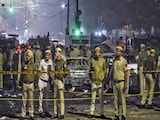Nepal has reached a remarkable milestone: the World Health Organization (WHO) has officially declared that rubella has been eliminated as a public health problem in Nepal. This achievement reflects years of hard work and unwavering commitment. "Nepal's success reflects the unwavering commitment of its leadership, persistent efforts of the health care workers and volunteers, and unstinting support of engaged and informed communities," Dr Catharina Boehme, officer-in-charge of WHO's South-East Asia office, said while echoing the findings of the SEA-Regional Verification Commission (SEA-RVC). According to WHO's SEA-RVC, the achievement is a result of both strong immunization campaigns and reliable surveillance systems.
What Is Rubella And Why Does It Matter?
Rubella, also known as German measles, is a contagious viral infection that usually causes a mild fever and rash. While rubella may appear harmless in children and young adults, it poses a very serious risk to pregnant women. If a woman contracts rubella during early pregnancy, it can cause Congenital Rubella Syndrome (CRS) in the baby, leading to birth defects such as hearing impairment, cataracts, heart problems, and developmental delays. According to the WHO, rubella remains a leading cause of preventable congenital disabilities in many countries. This is why eliminating rubella is considered a major public health priority across the world.
Nepal's Victory: A Landmark In Public Health
Nepal's strategy for eliminating rubella was multi-pronged and persistent. The rubella vaccine was introduced in 2012, covering children between the ages of nine months and fifteen years. A second dose was added to the national immunization schedule in 2016 to strengthen immunity. To maintain momentum, Nepal conducted four nationwide vaccination campaigns in 2012, 2016, 2020, and 2024. These campaigns ensured that even children who were missed earlier got vaccinated, keeping coverage high despite challenges such as the COVID-19 pandemic and devastating earthquakes.
By 2024, Nepal had achieved over 95% coverage for at least one dose of the rubella vaccine, a benchmark that the WHO considers essential for elimination. Alongside vaccines, Nepal also introduced innovative approaches such as dedicating an "immunisation month" every year, incentivising districts that achieved full coverage, and using community outreach to identify and vaccinate missed populations. Importantly, the country also developed one of the region's first robust laboratory testing algorithms for rubella, which helped strengthen disease surveillance and ensure that every suspected case was properly investigated.
With this achievement, Nepal joins the ranks of Bhutan, DPR Korea, the Maldives, Sri Lanka, and Timor-Leste, the other countries in the WHO South-East Asia Region that have successfully eliminated rubella.
Where Does India Stand? A Progress Report
India has also made remarkable progress in reducing rubella cases, although the journey is still ongoing. Here's a detailed look at India's current efforts and challenges:
National Immunization Framework
Since 2017, India's Universal Immunization Programme (UIP) has included the Measles-Rubella (MR) vaccine. Under this programme, children receive two free doses: the first between 9-12 months, and the second between 16-24 months. This nationwide rollout was a huge step towards rubella elimination.
Vaccination Coverage
According to official data from 2024-25, India has achieved around 93.7% coverage for the first MR dose and 92.2% for the second dose. While this is close to WHO's recommended 95% benchmark, the remaining gap highlights the need for sustained campaigns, especially in remote and underserved areas.
District-Level Achievements
Between January and March 2025, 332 districts in India reported zero measles cases, while 487 districts reported zero rubella cases. This is an encouraging sign that elimination is within reach if coverage can be maintained consistently across all states.
National Campaigns and Initiatives
In 2025, the government launched the National Zero Measles-Rubella Elimination Campaign, with the ambitious aim of reaching every child left out of previous drives. The campaign includes multilingual awareness materials, digital outreach, and a strong "ACT NOW" policy to encourage parents and caregivers to get children vaccinated without delay.
International Recognition
India's progress has not gone unnoticed. In 2024, India received the Measles and Rubella Champion Award for demonstrating leadership and robust immunization strategies. This international recognition has reinforced India's role as a regional leader in public health.
Mass Vaccination Drives
Since 2017, India has vaccinated over 348 million children against measles and rubella. Recent campaigns between November 2022 and May 2023 reached millions more, especially in high-risk states and urban areas where outbreaks were more likely.
Surveillance and Laboratory Strengthening
India has expanded its surveillance systems, including a strong network of laboratories, to track suspected cases. Case-based monitoring of "fever with rash" illnesses helps health officials quickly identify and contain outbreaks. Support from WHO's National Public Health Support Network has played a big role in these improvements.
State-Level Examples
States like Kerala have shown strong leadership. In May 2025, Kerala conducted a two-week MR vaccination drive across selected districts, using mobile booths and community campaigns. This drive achieved 92% coverage for the first doseand 87% for the second dose, with a special focus on migrant workers and hard-to-reach communities.
What Can The Public Do?
While government campaigns and international support are crucial, public participation is equally important in eliminating rubella. Parents should ensure that children receive both recommended MR doses on time. Families must participate actively in immunization drives, help spread awareness, and encourage relatives and neighbours to get vaccinated. Adults can also play a role by reporting suspected cases of fever and rash to local health authorities, which helps strengthen surveillance.
Nepal's success in eliminating rubella shows that strong leadership, community engagement, and consistent vaccination campaigns can indeed eradicate deadly viruses. India is very close to achieving the same milestone, but the final stretch requires unwavering commitment. With sustained immunization coverage, improved surveillance, and active public participation, India can eliminate rubella by 2026 and protect future generations from preventable suffering.
Disclaimer: This content including advice provides generic information only. It is in no way a substitute for a qualified medical opinion. Always consult a specialist or your own doctor for more information. NDTV does not claim responsibility for this information.















